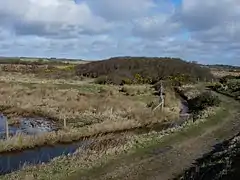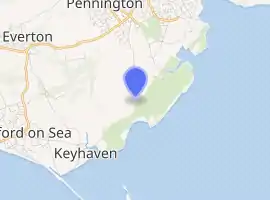Lymington and Keyhaven Marshes
Lymington and Keyhaven Marshes is a 738-hectare (1,820-acre) nature reserve which stretches from Keyhaven along the south coast across the Lymington River in Hampshire. It is managed by the Hampshire and Isle of Wight Wildlife Trust.[1] It is part of Solent and Southampton Water Ramsar site[2] and Special Protection Area.[3] Some areas are part of two Special Areas of Conservation, Solent and Isle of Wight Lagoons[4] and Solent Maritime and Solent.[5] It is also part of Hurst Castle and Lymington River Estuary, which is a Site of Special Scientific Interest,[6] and of North Solent Marshes Nature Conservation Review site, Grade 2.[7] Two areas are Geological Conservation Review sites,[8][9] and two are Local Nature Reserves, Boldre Foreshore[10] and Lymington-Keyhaven Marshes.[11][12]
| Lymington and Keyhaven Marshes | |
|---|---|
 Keyhaven Marshes | |

| |
| Type | Nature reserve |
| Location | Lymington, Hampshire |
| OS grid | SZ318927 |
| Area | 738 hectares (1,820 acres) |
| Managed by | Hampshire and Isle of Wight Wildlife Trust |
This coastal site has saltmarshes and intertidal muds. Birds of prey include peregrine falcons, marsh harriers and merlins, while black-headed gulls and sandwich terns feed on fish in the marshes. Yellow-horned poppies, sea campions and sea aster grow in the salty mud.[1]
There is no public access to the site.
| Wikimedia Commons has media related to Lymington-Keyhaven Marshes. |
References
- "Lymington and Keyhaven Marshes". Hampshire and Isle of Wight Wildlife Trust. Retrieved 26 May 2020.
- "Designated Sites View: Solent and Southampton Water". Ramsar Site. Natural England. Retrieved 23 April 2020.
- "Designated Sites View: Solent and Southampton Water". Special Protection Areas. Natural England. Retrieved 23 April 2020.
- "Designated Sites View: Solent and Isle of Wight Lagoons". Special Areas of Conservation. Natural England. Retrieved 23 April 2020.
- "Designated Sites View: Solent Maritime". Special Areas of Conservation. Natural England. Retrieved 23 April 2020.
- "Designated Sites View: Hurst Castle and Lymington River Estuary". Sites of Special Scientific Interest. Natural England. Retrieved 30 April 2020.
- Ratcliffe, Derek, ed. (1977). A Nature Conservation Review. 2. Cambridge, UK: Cambridge University Press. p. 6. ISBN 0521 21403 3.
- "Hurst Castle Spit (Coastal Geomorphology of England)". Geological Conservation Review. Joint Nature Conservation Committee. Retrieved 21 April 2020.
- "Keyhaven Marsh, Hurst Castle (Coastal Geomorphology of England)". Geological Conservation Review. Joint Nature Conservation Committee. Retrieved 21 April 2020.
- "Designated Sites View: Boldre Foreshore". Local Nature Reserves. Natural England. Retrieved 28 April 2020.
- "Designated Sites View: Lymington-Keyhaven Marshes". Local Nature Reserves. Natural England. Retrieved 24 April 2020.
- "Map of Lymington-Keyhaven Marshes". Local Nature Reserves. Natural England. Retrieved 26 May 2020.